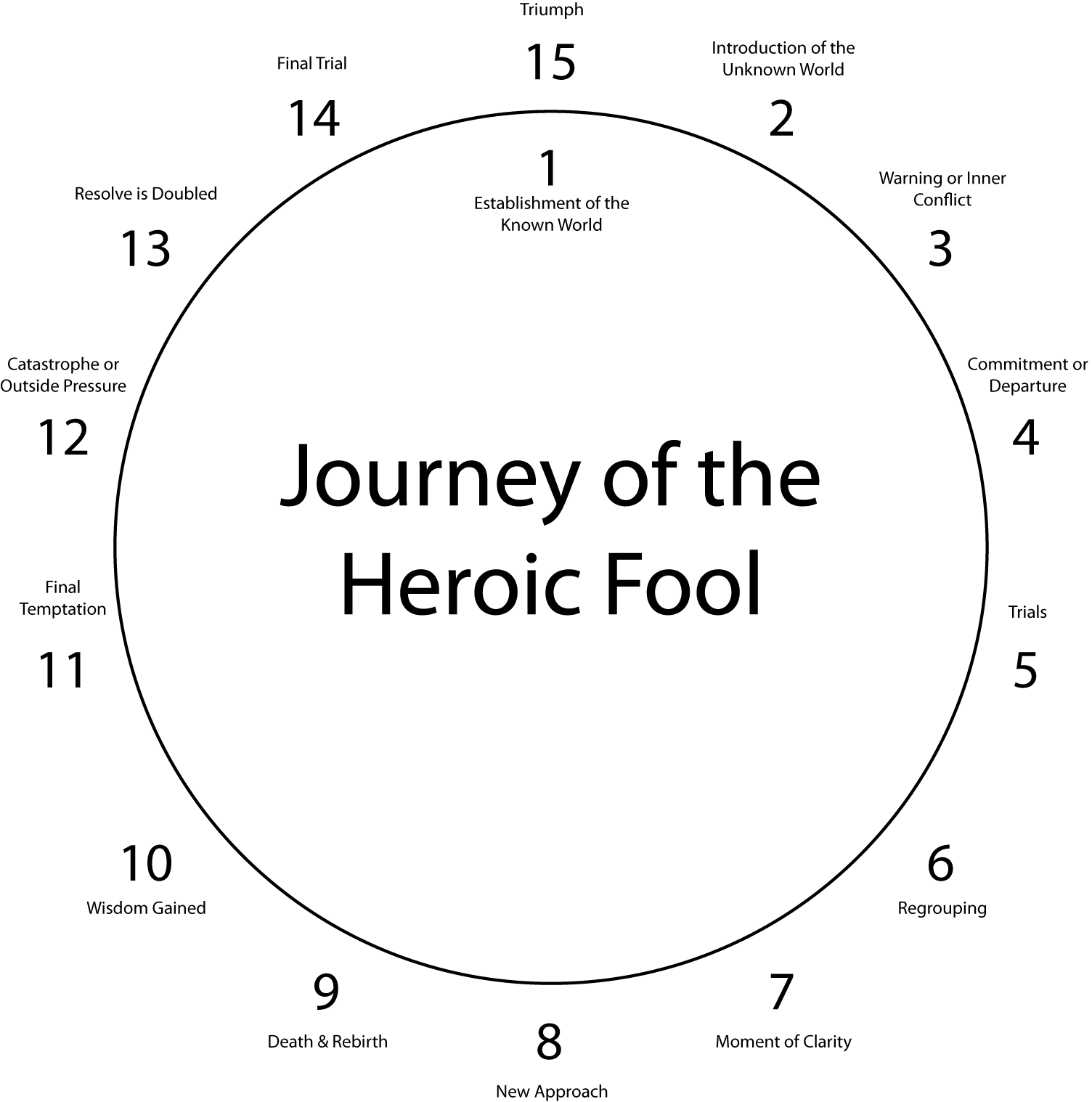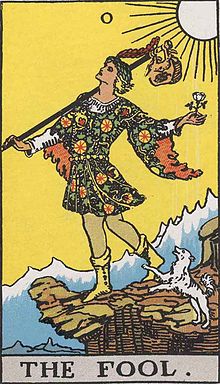Today I have the pleasure of welcoming a new regular contributor to the EFW gang. C. Brennecke, author of Seven Shards: The Colors of Wine, which is presently in production with Inkshares, joins us today with her first post, following this month’s lead on exploring character journeys in fantasy.
In writing circles, especially fantasy writing circles, it is inevitable that the Hero’s Journey will be referenced from time to time. The same can be said of the Fool’s Journey in Tarot circles. By some stroke of chance, I discovered both of these sequential story structures around the same time. I realized almost immediately that, despite coming from completely different areas of study, the Hero and the Fool had a lot in common.
The Hero’s Journey, the story structure that appears time and time again in books and other stories throughout the ages, begins in the “known world” or “ordinary world,” which is then left behind thanks to a Call to Adventure. The Fool’s Journey, which is the path of life or path to wisdom as told by Tarot, begins in the “outer world,” which is departed thanks to the decision to leave home, as depicted by the Chariot card. As the journeys continue, both the Hero and the Fool experience a death/rebirth cycle, and just before the very end, both experience a final crossroad as well.
Upon discovering these thematic overlaps, it occurred to me that it might be interesting to take a closer look and perhaps unite them into one hybrid journey. Thus, the seed of their marriage was born.
First, let’s take a look at the groom. Here is the Fool’s Journey, adapted for storytelling by yours truly. (To learn more about the Fool’s Journey, click here.)
- The Magician – We meet the Fool as he’s demonstrating his will/agency. This might be shown by a mastered skill, a rebellious decision, a recent accomplishment, learning to influence his environment. etc.
- The High Priestess – A foreshadowing of things to come. We get a hint that a much deeper world or greater opportunity is out there.
- The Empress – The Fool’s love for his family, friends, and/or home is established.
- The Emperor – The laws of the world are established, including expectations that are put upon the Fool.
- The Hierophant – The Fool’s beliefs are established. Alternatively, a mentor may give the Fool guidance or warning.
- The Lovers – A choice that inspires departure from the status quo. The Fool debates this decision and may face opposition from family, friends, or the law itself.
- The Chariot – The Fool goes all in on his decision, leaving home and/or loved ones behind.
- Strength – The decision is tested and the Fool endures. He demonstrates courage, cunning, resourcefulness, endurance, friendship, and/or kindness.
- The Hermit – The Fool regroups after his initial trial(s) and seeks out guidance as his resolve wanes. The guidance comes either from a mentor or through serious contemplation/meditation.
- Wheel of Fortune – A world change takes place corresponding with the maturation of the Fool.
- Justice – Having achieved moral clarity, the Fool faces his own faults and resolves to right them.
- The Hanged Man – The Fool faces a new point of view that challenges his own perspective. Instead of fighting it, he listens and learns. There may be a sacrifice at this stage.
- Death – The Fool’s original quest is completed, perhaps at great loss, and a new goal is taken up.
- Temperance – The Fool heals and learns to take a balanced approach in the pursuit of the new goal, incorporating the lessons he’s learned thus far.
- The Devil – The Fool is tempted or manipulated off his path. He may be scared or even captured by an enemy for a time.
- The Tower – An unexpected catastrophe takes place. A known establishment crumbles, either via physical destruction or the reveal of a huge secret that changes everything.
- The Star – The Fool focuses on his goal, receiving encouragement and support from another when needed most.
- The Moon – The Fool continues alone and his resolve momentarily wavers as he faces fear and confusion.
- Sun – A greater power (or powerful friend) comes to the Fool’s aid.
- Judgement – The final trial the the Fool must pass. This is a there’s-no-turning-back/now-or-never moment.
- The World – The Fool is triumphant. Celebration ensues.
Now, let’s take a look at the bride. Here is the Hero’s Journey, paraphrased in my own words. (To learn more about the Hero’s Journey, click here.)
- The Ordinary World – The Hero’s normal life and personal history is established. The Hero is unaware of the larger problems of the outside world.
- The Call to Adventure – The Hero is faced with a challenge or problem to overcome.
- Refusal of the Call – The Hero refuses or hesitates out of fear. Alternatively, another character might voice their doubts.
- Meeting with the Mentor – The Hero encounters a mentor (or beneficial object) that readies her for the task.
- Crossing the Threshold – The Hero commits to her task and leaves the known world to start the journey.
- Tests, Allies, and Enemies – The Hero learns about the new world she has entered. She encounters tests, foes, and new friends.
- Approach – The Hero and her new friends prepare for the major challenge ahead. A setback may occur, causing her to try a new approach or adopt new ideas.
- The Ordeal (Death and Rebirth) – The Hero encounters a major obstacle, usually a life or death scenario or the Hero’s greatest fear.
- The Reward – A temporary celebration. Having survived the Ordeal, the Hero accomplishes her goal or receives a reward.
- The Road Back – The Hero sets out to return home. There is a sense of urgency to the trip – ex.) the clock is ticking or an enemy is in pursuit.
- The Resurrection – The Hero faces a final test where everything is at stake. A sacrifice may be needed in order to pass this test.
- Return with the Elixir – The Hero returns home with her knowledge (“elixir”), which can be used to help others or be applied to future adventures.
And finally, let’s take a look at their marriage: The Journey of the Heroic Fool

- Establishment of the Known World
- Introduction of the Unknown World
- Warning or Inner Conflict
- Commitment and Departure
- Trials
- Regrouping
- Moment of Clarity
- New Approach
- Death and Rebirth
- Wisdom Gained
- Final Temptation
- Catastrophe or Outside Pressure
- Resolve is Doubled
- Final Trial
- Triumph
So what do you think? Is this new spin helpful? Or is it all a bit foolish?

 C. Brennecke is a fantasy writer, artist, and lifelong daydreamer. She works as a publications editor and organizes chaos for fun. Her first taste of world-building came when she discovered tabletop role-playing while studying art at Temple University, and she’s been creating worlds ever since. She spends many late nights on the computer in her suburban Philadelphia home, which she shares with her husband and a Sheltie that thinks he’s a cat.
C. Brennecke is a fantasy writer, artist, and lifelong daydreamer. She works as a publications editor and organizes chaos for fun. Her first taste of world-building came when she discovered tabletop role-playing while studying art at Temple University, and she’s been creating worlds ever since. She spends many late nights on the computer in her suburban Philadelphia home, which she shares with her husband and a Sheltie that thinks he’s a cat.
Check out her website: http://www.mythsmistsmusings.com or follow her on twitter: @bonebonetweets


This is a fascinating hybrid, Christine! Just curious, but have you used, or do you have plans to use, this model for your storytelling? Or do you know of any stories that would fall under this category? I’d love to see this in action, even look at a story broken down by its events to see where each steps falls. Perhaps a sequel post at a future date? Great to have you on board 🙂
Thanks, John! And yes, I do plan on penning a follow-up post on my website at some point. I will definitely apply it to my own characters, and might choose another well-known tale to pull examples from too.
Thanks for asking – and for inviting me 🙂
Reblogged this on Archer's Aim and commented:
A bit of foolishness with the hero’s journey. Reblogging on Archer’s Aim.
Pingback: When Things Change, Or Why I’m Writing About My Own Story – By Elan Samuel | John Robins Blog
I’m glad I finally got around to reading this. I’ve never felt the Hero’s Journey really applied to my writing style, and after seeing the similarities(and more importantly the subtle differences) I realize that I tend to write about the Fool’s Journey more often than not, especially as laid out in your hybrid Journey of the Heroic Fool. Its comforting to finally see a structure that fits with my own. I think I may have to do my own follow up at my blog referencing this and noting how it applies to my work.
I am positively thrilled to hear this, Thomas! I really wasn’t sure if my oddball approach would resonate with anyone, so discovering that it has is quite comforting to me too. I’m really excited to hear more about your work and to discover how this matches your story structure.